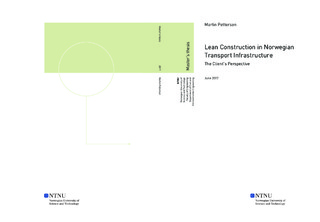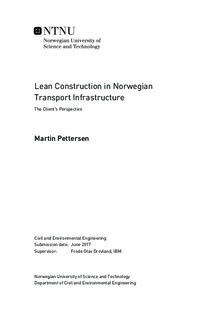| dc.description.abstract | The construction industry lags in efficiency compared to other industries, thus it needs higher performance. Lean construction (LC) has been adapted over many years as a competitor to traditional project management. Studies indicate the same problems to performance in transport infrastructure as to the building sector, however there are significantly less research that refer to LC in transport infrastructure. This study reviews LC in Norwegian transport infrastructure from the client s perspective. The problem of the study is:
Map the current situation and review the possibilities of further implementing the lean methodology to Norwegian public infrastructure agencies operating in road and railroad.
The study is approached with a qualitative research method, thus interviews and existing literature has been the source of information. The cases of study are Bane NOR, Nye Veier, Statens Vegvesen (SVV) and Statsbygg. One representative of each organization is interviewed, and Statsbygg only for comparison purposes. The interviewees are key members of their organizations, thus the findings are precise. Findings show that lean has been implemented by Bane NOR and Nye Veier, however that SVV does not work with the lean methodology. Bane NOR has implemented a lean transformation that corresponds perfectly with Womack and Jones (2010) principles of lean to their operations and maintenance division. Nye Veier works with standardizing procedures and reducing waste in the organization, and approaches projects with a high-end focus on early involvement of contractors and suppliers.
This study finds that there are no specific challenges related to transport infrastructure, seen from the client s perspective. Implementing the lean methodology to the client s organizational framework equates to that of organizations operating in other industries. The differences between transport infrastructure and building projects, being the location and that transport infrastructure is more sequential, surely cannot reject the Lean Project Delivery System. However, some challenges in implementing Set-based strategies and alignment of stakeholder interests occur due to public tender rules in Norway and the status of to which lean is being currently used. This study has discussed the project model of Nye Veier to SVV, being respectively a design-build model that involves contractors early versus design-bid-build with practically lowest price as award criteria. Issues that occur with design-bid-build and lowest price as award criteria are a high number of change-orders and cost-overruns. These issues correlate to lack of alignment of stakeholder interest.
No prior studies have been done mapping the current situation and reviewing the possibilities of further implementing the lean methodology to Norwegian transport infrastructure, thus this is the first of its kind. The value of this study is that it opens for further research on the topic. This study suggests, however cannot conclude as performance indicators are not available, that more use of design-build or other co-operative models, and Target Value Design (TVD) with share in risk and responsibility can lead to increased performance in transport infrastructure. Further research should include case studies that compares the performance of Nye Veier s approach to SVV, and evaluates the effect of TVD with share in risk and responsibility. | |

